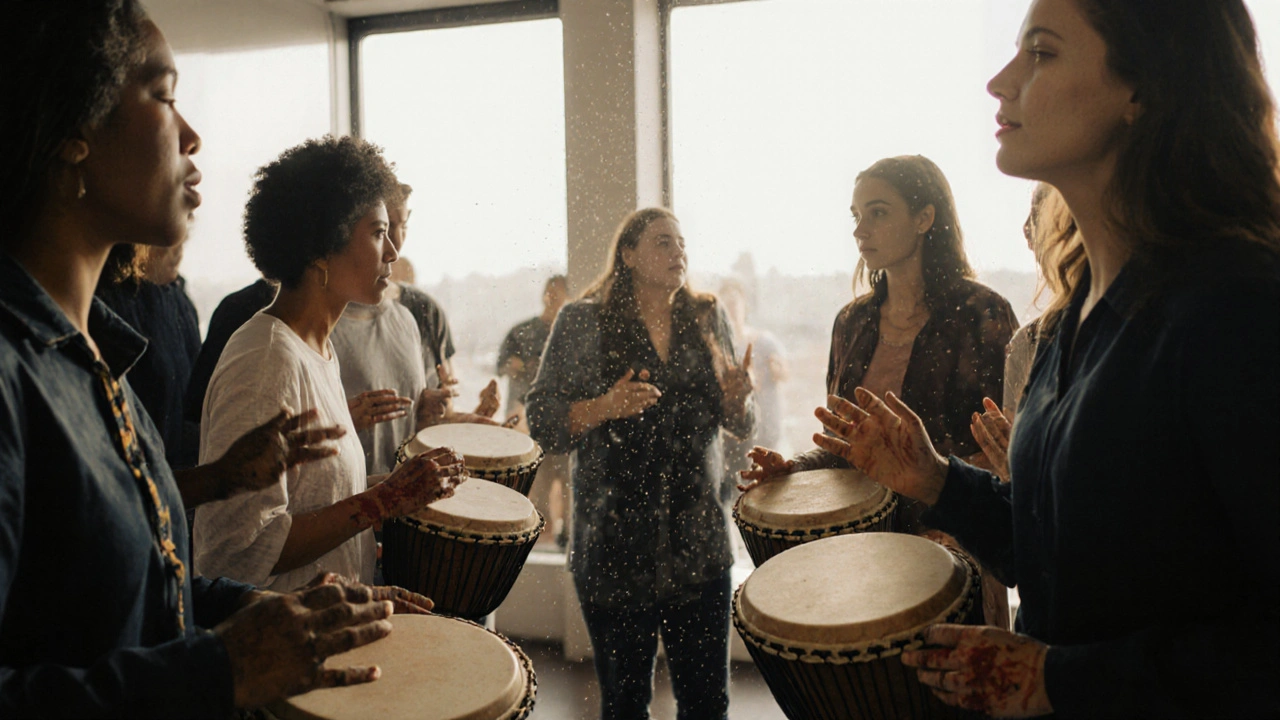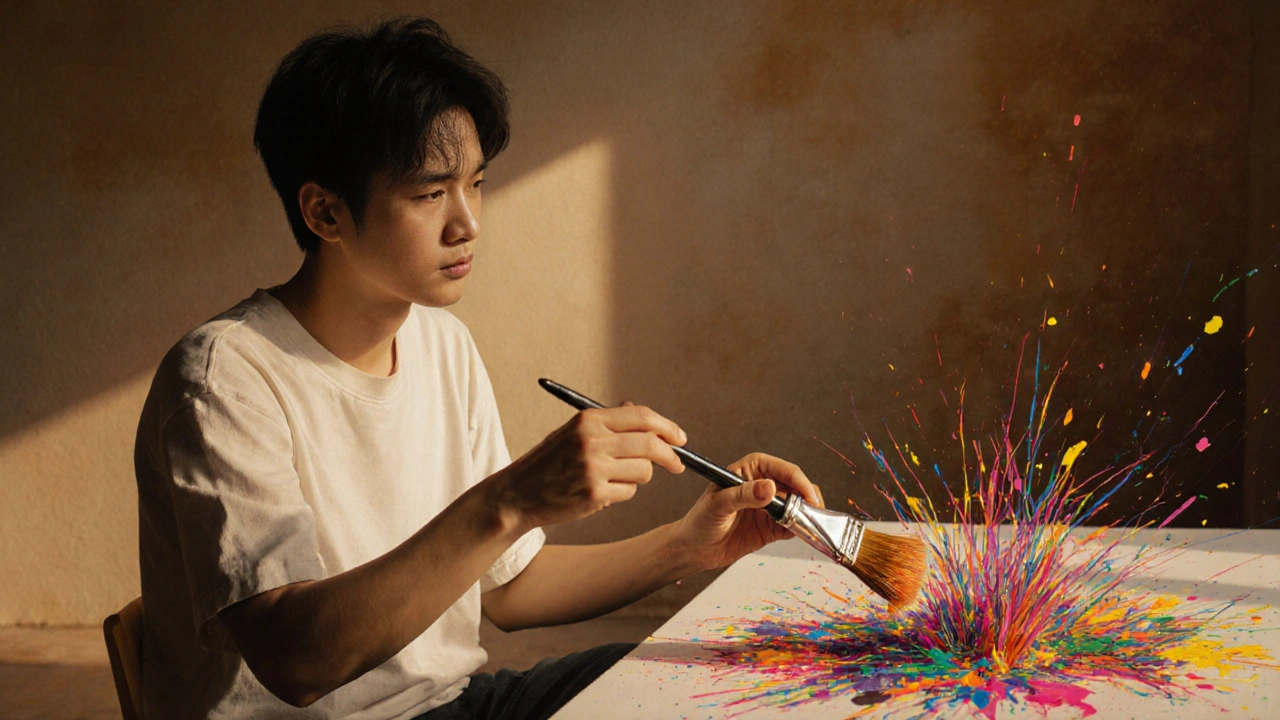What if the key to healing isn’t in talking more-but in making something? Creative arts therapies aren’t about becoming a professional artist, musician, or dancer. They’re about using creativity to process what words can’t reach. If you’ve ever felt stuck in your thoughts, overwhelmed by emotions you can’t name, or just plain tired of therapy that only asks you to talk, this might be the missing piece.
What Exactly Are Creative Arts Therapies?
Creative arts therapies are clinical, evidence-based practices that use art, music, dance, drama, or writing to help people express feelings, reduce stress, and heal emotional wounds. Unlike taking a painting class or joining a choir for fun, these therapies are led by certified professionals trained in both art and psychology. They don’t care if your drawing looks good or if you can’t carry a tune. What matters is what comes out-and how it makes you feel.
The American Art Therapy Association defines art therapy as a practice that helps people explore emotions, develop self-awareness, manage behavior, and reduce anxiety. Music therapy, recognized by the American Music Therapy Association, uses rhythm, sound, and improvisation to improve communication and emotional regulation. Dance/movement therapy, grounded in the idea that body and mind are connected, helps release tension stored in muscles and posture. Even drama therapy lets you step into someone else’s shoes-literally-to understand your own story better.
These aren’t new ideas. Ancient cultures used drumming, storytelling, and ritual movement to heal. Today, research backs them up. A 2023 meta-analysis in the Journal of Clinical Psychology found that creative arts therapies significantly reduced symptoms of depression and PTSD in adults, with results matching or exceeding traditional talk therapy in some cases.
How It Works: When Words Fall Short
Think about the last time you were really upset. Did you sit down and say, “I feel a deep sense of existential unease mixed with unresolved childhood grief”? Probably not. You likely clenched your jaw, cried, or scrolled endlessly on your phone. Our brains don’t always process pain through language. Sometimes, trauma lives in the body. Grief hides in silence. Anger gets buried under busyness.
Creative arts therapies bypass the thinking mind. When you smear paint across paper, you’re not analyzing your emotions-you’re releasing them. When you pound a drum, you’re not telling someone you’re angry-you’re letting your body scream for you. When you move without rules, you’re rediscovering freedom your mind forgot you had.
One woman in Wellington, who struggled with panic attacks after losing her partner, started attending a weekly music therapy group. She couldn’t sing. She didn’t play instruments. But she began tapping rhythms on a drum. Over months, her breathing slowed. Her panic attacks dropped from daily to once a week. She didn’t talk about her grief until the third session. But the drum told the story before she could.
Art Therapy: Painting Your Inner World
Art therapy doesn’t require skill. It requires honesty. You don’t need to know how to draw a face to make a meaningful piece. A scribble can hold more truth than a perfect portrait. In sessions, people often start with simple prompts: “Draw your mood today,” “Paint a safe place,” or “Create something that represents your anger.”
Therapists then help you explore what you made-not by interpreting it for you, but by asking questions: “What do you notice about the colors you chose?” “Where did your hand want to go first?” “Does this image feel heavy or light?”
Studies show art therapy reduces cortisol levels-the stress hormone-within just one session. People with chronic illness, trauma, or autism often respond better to visual expression than verbal dialogue. A 2024 study in Arts in Psychotherapy found that cancer patients who engaged in weekly art therapy reported higher emotional resilience and improved sleep than those who only received standard counseling.
Music Therapy: Rhythm as Medicine
Music doesn’t just soothe. It rewires. Rhythm regulates heartbeat. Melody calms the nervous system. Improvisation gives control back to those who’ve lost it.
Music therapists work with people across the spectrum-from children with autism who rarely speak, to veterans with PTSD who can’t sleep. A common technique is guided music listening, where a therapist picks songs that match the client’s emotional state, then gradually shifts to more uplifting or calming tracks. Another method is drum circles, where participants create rhythms together. No one leads. No one follows. Just sound. Connection.
For people with dementia, familiar songs from youth can trigger memories long thought lost. One man in Auckland, diagnosed with early-onset Alzheimer’s, hadn’t spoken to his family in months. Then his therapist played “My Way” by Frank Sinatra-the song he danced to at his wedding. He started humming. Then singing. Then crying. He held his daughter’s hand for the first time in a year.

Dance and Movement Therapy: Let Your Body Speak
How you hold your body says more than you think. Slumped shoulders. Crossed arms. Tense jaw. These aren’t just habits-they’re stored emotions.
Dance/movement therapy is based on the principle that movement reflects inner states. A therapist observes how you walk, sit, gesture. Then invites you to move freely-not to perform, but to express. You might sway like wind, stomp like anger, or curl up like a child seeking safety.
This form of therapy is especially powerful for trauma survivors. Trauma freezes the body. Movement helps it thaw. A 2022 trial with survivors of domestic violence showed that after 12 weeks of dance therapy, participants had lower anxiety scores and higher self-esteem than those in standard cognitive therapy.
You don’t need to be flexible or coordinated. In fact, stiffness often means the most healing is needed. One client, a retired teacher with chronic back pain, said her first movement session felt like “my body finally remembered it was allowed to breathe.”
Writing and Drama: Telling Stories That Heal
Journaling is a form of creative therapy too. But expressive writing goes deeper than diary entries. It’s about writing without stopping for 10-15 minutes, even if it’s nonsense. No editing. No judgment. Just letting the mind spill out.
Drama therapy adds role-play. You might write a letter to your younger self-and read it aloud. Or become the part of you that’s afraid, and have a conversation with the part that’s brave. These aren’t acting exercises. They’re emotional experiments.
Research from the University of Auckland found that people who wrote about traumatic events for 20 minutes a day over four days showed measurable improvements in immune function and reduced doctor visits in the following months.
Who Can Benefit?
You don’t need a diagnosis to try creative arts therapies. They’re not just for people with mental illness. They’re for anyone who feels disconnected-from themselves, from others, from joy.
People use them for:
- Managing anxiety and depression
- Processing grief or loss
- Healing from trauma or abuse
- Coping with chronic illness
- Improving self-esteem
- Reducing burnout
- Supporting neurodivergent individuals
- Rebuilding connection after isolation
Even high-performing professionals-lawyers, nurses, teachers-find these therapies help them reset. One nurse in Christchurch told me, “I save lives all day. But I didn’t know how to save myself. Painting gave me back my quiet.”

How to Get Started
You don’t need to wait for a referral. Start small.
- Keep a sketchbook or journal. Don’t aim for beauty. Aim for honesty. Doodle when you’re stressed.
- Put on music that matches your mood. Then change it. Notice how your body responds.
- Stand in front of a mirror. Move your arms slowly. Don’t think. Just follow the impulse.
- Write a letter you’ll never send. Then burn it. Or keep it. Doesn’t matter.
- Find a local group. Many community centers in New Zealand offer low-cost or free creative arts therapy sessions. Check with your local mental health service or library.
If you want structured support, look for a registered creative arts therapist. In New Zealand, the New Zealand Association of Creative Arts Therapists (NZACAT) maintains a directory of certified practitioners. They hold a master’s degree and are trained in ethics, psychology, and one or more art forms.
What to Expect in a Session
First sessions are usually about safety and choice. The therapist will explain the process. You’ll be asked what you’d like to explore. There’s no pressure to create anything. You can sit quietly. You can cry. You can refuse to draw. That’s okay.
Over time, you might begin to notice patterns: the same color keeps appearing. The same rhythm keeps showing up in your drumming. The same posture returns when you move. These aren’t accidents. They’re clues.
The goal isn’t to “fix” yourself. It’s to understand yourself better. To feel less alone in your inner world. To find a voice-even if it’s silent, painted, or danced.
Why This Matters Now
We live in a world that values productivity over presence. We’re told to meditate, breathe, and “just relax”-as if healing is a checklist. But trauma doesn’t care about your to-do list. Grief doesn’t wait for your next Zoom call.
Creative arts therapies offer something rare: permission to feel without explaining. To be messy. To be human. To create something that only you understand-and that’s enough.
You don’t need to be an artist. You just need to be willing to try something different. Maybe that’s the first step to healing.
Do I need to be artistic to benefit from creative arts therapies?
No. Creative arts therapies aren’t about talent or skill. They’re about expression. Whether you’ve never held a paintbrush or haven’t danced since high school, it doesn’t matter. The focus is on what you feel, not what you produce. A messy scribble can be more healing than a perfect painting.
Are creative arts therapies backed by science?
Yes. Hundreds of peer-reviewed studies show benefits for depression, PTSD, anxiety, chronic illness, and autism. For example, a 2023 meta-analysis in the Journal of Clinical Psychology found creative arts therapies reduced symptoms as effectively as traditional talk therapy, and sometimes better-especially for people who struggle to verbalize emotions.
Can I do this on my own, or do I need a therapist?
You can start on your own with journaling, music, or free movement. Many people find relief this way. But if you’re dealing with trauma, deep grief, or mental health conditions, working with a certified therapist adds safety and structure. They’re trained to guide you through intense emotions without retraumatizing you.
How long does it take to see results?
Some people feel a shift after one session-like a weight lifted or a breath taken. For lasting change, most people attend weekly sessions for 8 to 16 weeks. Healing isn’t linear. Some weeks feel easier. Others bring up old pain. That’s part of the process.
Is this covered by health insurance in New Zealand?
Some private health insurers in New Zealand cover creative arts therapies if delivered by a registered practitioner. ACC may cover sessions if your issue stems from an accident or workplace trauma. Public services like district health boards sometimes offer free or low-cost groups through community mental health programs. Check with your provider or local health center.







